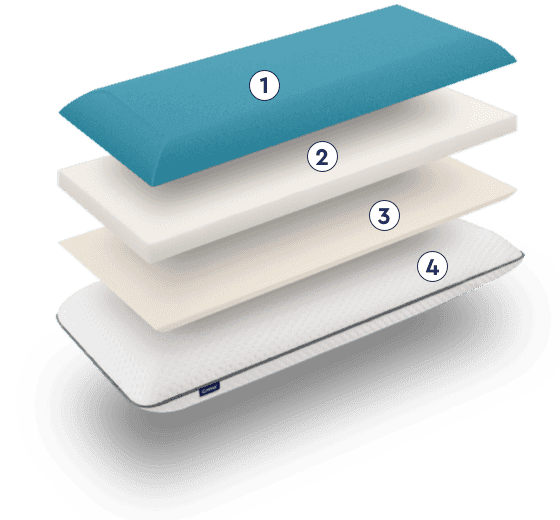Best mattresses for sleeping on the back, Guide, 2022

When buying a mattress, there are a lot of details to weigh up. People consider their height, weight, if they are sleeping as a couple, etc. One area that could be forgotten about, though, is how you sleep; your sleeping position. Whether you are a side sleeper, stomach sleeper, or back sleeper, you will experience problems if you do not purchase the appropriate mattress. Back-sleeping is not commonly adopted by people, but has numerous benefits linked to it. If you are a back-sleeper, then you should take into account the firmness of a mattress, its weight distribution capabilities, its pinpoint pressure-relief, its depth and you should even carefully weigh up what sort of pillow would allow to you have a great sleep.
Why certain mattresses can cause back-sleepers problems
Back-sleepers are quite a rare breed. According to studies only 10% of people generally sleep in this way. This is fractional in comparison to the 70% that apparently sleep on their side. In fact, back-sleeping is even according to statistics less common than stomach-sleeping making it the rarest kind of sleeping position. One variation of back-sleeping is called the ‘soldier’. This is when you are sleeping on your back with your hands by your side like a regimented soldier. Apparently, about 8% of people sleep in this way. Another back-sleeping position is the ‘starfish’. This is when you sleep on your back with your hands above the head as opposed to by the side. This is a bit less common sleeping style than the ‘soldier’ position with about 5% of the general population sleeping in this way.

You also have the Savasana. This is when you sleep, facing upwards, with your arms flat and palms facing upwards slightly away from your torso and your legs about shoulder-width apart. This is one of the healthiest forms of sleeping as it allows for joint relief as the elbows and knee joints are kept in neutral positions. In fact amongst the group of side-sleeping, stomach-sleeping and back-sleeping it is back-sleeping that is generally regarded as the healthiest form of sleeping, despite feeling to the majority of people, based on the statistics, to be the most unnatural of them all. Of course, as with any kind of sleeping position, there are advantages and disadvantages to sleeping on the back. Firstly, back-sleeping is the best for spinal alignment.
Stomach-sleeping is known to disrupt the natural linear shape of the spine. However, back-sleeping on a suitable mattress promotes neutral alignment. It also reduces acid reflux and removes the chance of bed materials contributing to facial wrinkles because when lying supine, your face isn’t pressed against a pillow or the mattress. With these benefits, it is no wonder that some experts offer advice on training yourself to convert to back-sleeping if you don’t already.
However, a downside of back-sleeping is that it is known to worsen snoring or sleep apnea. As certain forms of sleep apnea involve airflow being restricted and even breathing being stopped momentarily at times, it can be quite serious.
It is important to be aware that if the mattress is badly lacking in certain aspects you may lose some of the usual benefits of back-sleeping.
Some problems that come with back-sleeping
The problems | |
| 1 | Back-sleepers who have lower back pains have found that their sleeping style doesn’t help and can even make their pains worse. Since the lower back and buttocks are one of the pressure points when back-sleeping, a long sleep can cause put immense pressure on this region if the mattress doesn’t help. |
| 2 | Although back-sleeping is the position that keeps the spine most neutrally aligned, this can be compromised by a mattress that allows the buttocks and shoulders to sink into the mattress significantly deeper than other parts of the body. This will produce over-flexion, which is when the spine will experience unnatural and damaging curvature. |
| 3 | Sometimes, if a pillow is not appropriate you can find your neck is misaligned with your back and this can cause discomfort. |

Mattress and pillow solutions for backs-sleepers
| The Solutions | |
| 1 | The buttocks and shoulders need the most support when you are a back-sleeper. This requires specific pressure relief in these areas. For this reason, you should select a mattress that is adaptable to differing pressure areas of a sleeping person. Pocket spring or memory foam mattresses or a mattress that includes these constructions in it are ideal for this pressure relief. The pocket-spring mattress contains many coils that are each isolated in sheathed pockets. This separation allows coils to compress independently when you are back-sleeping and this means as greater force will occur under the shoulder and buttocks, the compression will be adjusted and the absorption properties of the coils will ensure adequate comfort in these areas. A memory foam mattress has a high level of viscoelastic which basically means that it is almost semi-fluid, semi-solid. This means that it will conform to the pressure of the shoulder and lower region, but the elasticity will enable you to reshape, so that it doesn’t let you sink in too far. The Emma Original is a memory foam mattress that could help in this way. |
| 2 | To prevent the advantage that back-sleeping brings to spinal alignment, you need to look at the firmness of the mattress. If the mattress is too soft it will let the pressure point areas of the body fall out of alignment and over-flexion will result. If the mattress is too firm, the contouring capacity could be rendered useless and the natural curve in the lumbar region could be impaired which would be uncomfortable. It is recommended to lean a bit more to the firmer side, though and if the mattress is foam, that would be an Indention Force Deflection figure of about 14. The Emma original has an HRX foam base which is designed to offer support for the lumbar region, so it could be what you’re after.However, if you are heavier than the average person it is recommended to go for a mattress that is about 16 on the IFD scale because you will need more support. |
| 3 | To stop your pillow from being the reason for neck pains, you should go for a pillow that is balanced between being plush and supportive. A pillow that is too firm wouldn’t allow your neck to fall into a position that lines up with your spine and it will be bent. This is especially the case if it is high-loft too. A pillow that matches these criteria is the Emma original pillow with its numerous layers which provide excellent padding and support.Therefore you should go for a pillow that is of a medium loft between 3 to 6 inches and has head contouring abilities. This is why memory foam pillows are recommended. However down pillows will also give you adequate comfort and promote spinal alignment. |
Get the sleep you deserve with our mattress and sleeping product reviews.
© Undercover Mattress 2022






